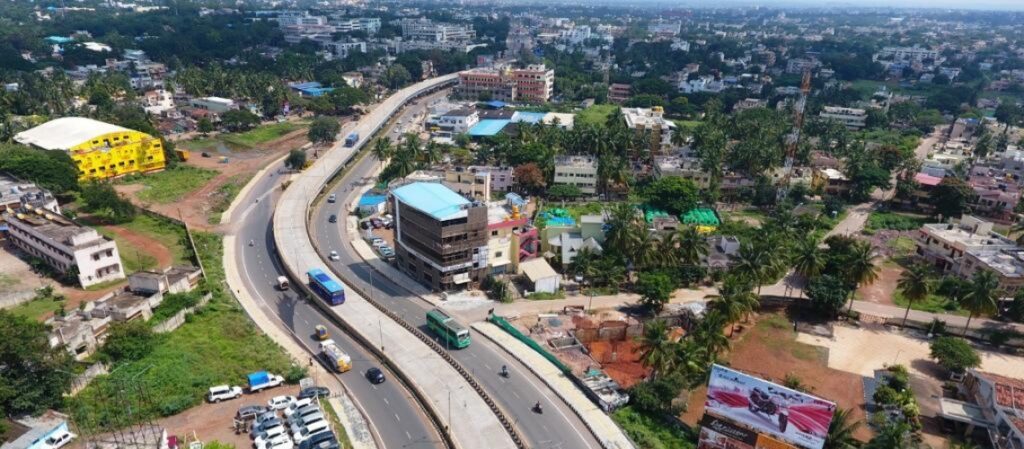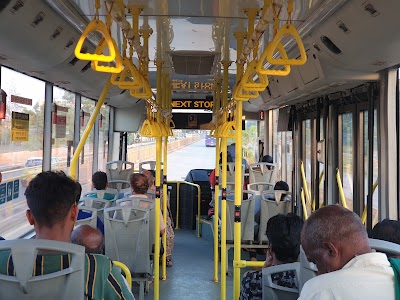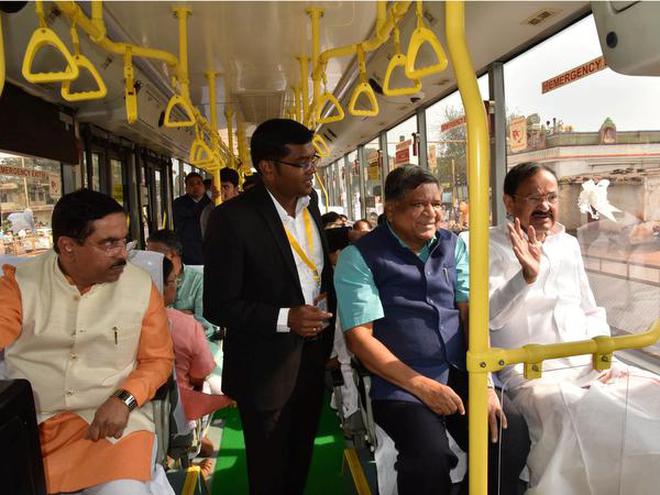How transit-oriented development projects in Hubli-Dharwad, India, are making commutes faster and more sustainable than ever
Nestled in the uplands of southwestern India, the twin cities of Hubli and Dharwad sit 22 kilometers apart. Together, they make up one of the most populous urban areas in the state of Karnataka, but all siblings have their own special skills and strengths, and Hubli and Dharwad are no different. Hubli, the commercial center, is a bustling trading hub for handloom textiles and peanuts and cotton from rural growers. Dharwad, on the other hand, is a vibrant administrative and academic hub, home to a throng of diverse colleges bustling with students. Over the last half century, the twin cities have grown substantially (Adhvaryu & Mudhol, 2021), and in the early 2010s, they came to a crossroads. Their unique roles in the local economy made them inextricably linked, yet physically, the hubs were only connected by one highway, PB Road.
As their populations expanded, Hubli and Dharwad fell victim to urban sprawl and a rise in personal cars. Across India, the number of registered motor vehicles rose 700-fold between 1951 and 2015, with a total of over 210 million cars filling the streets by the mid-2010s (Nasim & Chattopadhyay, 2018). With this rapid growth, roads were quick to become congested, leading to traffic jams and lengthy commutes, which in turn increased fuel consumption and carbon emissions. Personal cars accounted for a growing share of CO2 emissions, a key driver of climate change globally, and tailpipe emissions threatened the health of local populations (Gupta & Garg, 2020). As particulate matter and nitrogen oxides poured out of exhaust pipes, the risk of respiratory illness, stroke, heart attack, and lung cancer among residents of the twin cities climbed (Gupta & Garg, 2020; U.S. Department of Transportation, 2015).
Seeing these issues on the horizon, policymakers in Hubli-Dharwad knew they needed to address the growing use of personal cars early on in the cities’ development, before they became “locked-in” to their infrastructure design and the social and environmental costs associated with it (Hammad et al., 2019). As Vice President M. Venkaiah Naidu told The Hindu, “Development must not happen at the cost of quality of life. I strongly believe that we need a proactive model of urbanization rather than a reactive one” (“‘Development shouldn’t hit'”, 2020). Luckily for policymakers in Hubli-Dharwad, there was a clear opportunity to address urbanization’s woes before it was too late. The twin cities had a bus system with substantial potential for growth, carrying 70% of all commuters while only accounting for 7% of all vehicles on the road (“Hubli-Dharwad BRTS”, 2016). Likewise, of all total bus commuters in Karnataka in 2016, 62% were traveling between the twin cities (“Hubli-Dharwad BRTS”, 2016). If the trip between the cities’ centers became more efficient, Hubli and Dharwad could make huge strides toward sustainable development.
Thus, the Hubli-Dharwad Bus Rapid Transit System (HD-BRTS) was born.
Financed by the twin cities’ joint government and the World Bank, leaders in Hubli-Dharwad set out in 2012 to provide safe, fast, and sustainable public transportation between the city centers, minimizing urban sprawl and reducing carbon emissions from transportation. Their vision was this: widen the current four-lane highway to span 8 lanes and reserve 3-4 of the central lanes for public buses. Separated from the rest of the vehicles on the road, buses could avoid traffic and travel with better fuel efficiency, thus reducing carbon emissions, air pollution, and travel times. The bus corridor would span 20 km and include 26 stops, located on a central median and accessible to passengers via pedestrian bridges. Once aboard one of the 100 low-emissions buses, called Chigari, commuters would be able to reach their destination quicker and with a smaller environmental footprint.

Source: World Bank
If policymakers in Hubli-Dharwad could compel commuters to transition from car transport to commuting by bus, benefits from the program would extend far beyond convenient transportation and shorter commute times. Evidence shows that cities can significantly reduce travel-related CO2 emissions if they effectively persuade residents to switch to low-carbon transportation (Liu et al., 2017). In India, cars account for 31% of total car emissions but only 4% of passengers (Nasim & Chattopadhyay, 2018). Meanwhile, buses contribute 33% of carbon dioxide emissions while carrying 58% of all passengers (Nasim & Chattopadhyay, 2018). There was huge potential for reducing the carbon footprint from transportation, and this shift would also shrink tailpipe emissions that endanger human health. In 2015, air pollution from transportation was estimated to have caused 74,000 deaths in India, and studies in the region have shown that by reducing total car emissions, population health outcomes can be significantly improved (“Vehicle fumes led”, 2019; Bansal & Bandivadekar, 2013). With the simple yet transformational design of the HD-BRTS, project leaders had high hopes that the bus corridor could make large and lasting impacts.

Source: MapsUS
In October 2018, the HD-BRTS launched in Hubli-Dharwad, ushering in a new era in the twin cities. The system cut 10-15 minutes off the commute times for buses with frequent stops and 30 minutes for express buses from Hubli to Dharwad, drastically improving daily commutes (Gupta, 2020). The program proved popular, with Chigari transporting as many as 95,000 commuters daily one year into the project (“Hubli-Dharwad BRTS”, 2016; Adhvaryu & Mudhol, 2021). Passengers applauded the ease of access of the buses, and satisfaction was over 85% at the one-year mark (Gupta, 2020). Importantly, the corridor was successful in its goal of attracting new bus commuters, with one in five Chigari passengers switching from other modes of transportation to the HD-BRTS (Gupta, 2020).
However, when the COVID-19 pandemic hit in early 2020, the project’s progress was at risk of coming to a screeching halt. Riders became far and few between as commuters began to work from home, and with wider gaps between bus departure times, passengers who were eager to ride the Chigari found it difficult to do so, forcing many to once again reach for their car keys (Bomnalli, 2020). Software company employee Rajesh Singh was one of these riders who switched to commuting via car during the pandemic. As quoted in The Times of India, Singh lamented, “It’s not at all cost effective [to commute via car]. I used to commute in HD-BRTS buses before the pandemic… There is less [consistency] compared to other normal services” (Bhorde, 2020). It was dedicated riders like Rajesh who ensured that the pandemic wouldn’t permanently derail the project. As lockdown restrictions waned, the HD-BRTS ramped up their services, and passengers returned en masse. Once again, the bright blue buses pulsed through PB Road and commuters trickled in to fill the Chigari’s plastic seats. The bus corridor was no longer a trial program but a pillar of people’s lives.

Source: The Hindu
This year marks ten years since the bus corridor was first conceptualized. Despite the progress over the last decade, there is still more work to be done, and the project continues to explore new ways to reduce its carbon footprint. In 2021, 25 electric buses were added to the fleet to further minimize carbon emissions (“25 E-Buses”, 2021), and this year, 5,000 trees were planted along the corridor (“Hubballi-Dharwad BTS focuses”, 2022). On a larger scale, local policymakers have debuted the Hubli Dharwad 2030 City Development Framework, the first of its kind in India (Ollivier et al., 2021). They aim for a compact, multi-use zoning design connected by comprehensive public transit, and these goals make the bus corridor more important than ever.
The drive for innovation in the twin cities continues. As the chairman of the project V. Manjula put it, “We cannot rest on our laurels. The goal should be to raise the bar in terms of BRTS operations [and] maintenance of infrastructure… so as to make the BRTS corridor the jewel in the crown of Hubballi-Dharwad” (Manjula, 2022).
References
Adhvaryu, B., & Mudhol, S. S. (2021). Visualising public transport accessibility to inform urban planning policy in Hubli-Dharwad, India. GeoJournal, 1-25. Advance online publication. https://doi.org/10.1007/s10708-021-10548-6
Bansal, G., & Bandivadekar, A. (2013). Overview of India’s Vehicle Emissions Control Program: Past Successes and Future Prospects. International Council on Clean Transportation. https://theicct.org/sites/default/files/publications/ICCT_IndiaRetrospective_2013.pdf
Bhorde, K. S. (2020 October 1). Hubballi: HDBRTS ridership is rising slowly and steadily. The Times of India. https://timesofindia.indiatimes.com/city/hubballi/hdbrts-ridership-is-rising-slowly-and-steadily/articleshow/78415770.cms
Bomnalli, M. H. (2020, June 11). ‘Chigari’ passengers rise by over 3 times in initial week. Deccan Herald. https://www.deccanherald.com/state/karnataka-districts/chigari-passengers-rise-by-over-3-times-in-initial-week-848511.html
‘Development shouldn’t hit quality of life.’ (2020, February 2). The Hindu. https://www.thehindu.com/news/national/karnataka/naidu-stresses-on-need-for-efficient-mass-transportation/article30719760.ece
Gupta, N. (2020, February 27). India: New Bus Rapid Transit System makes travel faster, safer and more convenient in Hubballi-Dharwad. World Bank Blogs. https://blogs.worldbank.org/endpovertyinsouthasia/india-new-bus-rapid-transit-system-makes-travel-faster-safer-and-more
Gupta, D., & Garg, A. (2020). Sustainable development and carbon neutrality: Integrated assessment of transport transitions in India. Transportation Research Part D: Transport and Environment, 85, 102474. https://doi.org/10.1016/j.trd.2020.102474
Hammad, A., Akbarnezhad, A., Haddad, A., & Vazquez, E. (2019). Sustainable Zoning, Land-Use Allocation and Facility Location Optimisation in Smart Cities. Energies, 12(7), 1318. MDPI AG. Retrieved from http://dx.doi.org/10.3390/en12071318
Hubballi-Dharwad BRTS focuses on green initiative. (2022, February 17). The Hindu. https://www.thehindubusinessline.com/news/national/hubballi-dharwad-brts-focuses-on-green-initiative/article65058824.ece
Hubli-Dharwad BRTS: Providing sustainable transit solutions. (2016, April). Indian Infrastructure. https://indianinfrastructure.com/2016/04/01/hubli-dharwad-brts/
Liu, Z., Ma, J., & Chai, Y. (2017). Neighborhood-scale urban form, travel behavior, and CO2 emissions in Beijing: implications for low-carbon urban planning. Urban Geography, 38(3), 381-400, doi: 10.1080/02723638.2016.1191796
Manjula, V. (2022). Note from Chaiman’s Desk. Hubballi-Dharwad BRTS. https://www.hdbrts.com/en/about-us/chairman-s-desk/
Nasim, U., & Chattopadhyay, V. (2018). Indian roads belong to motorised vehicles, not cyclists or pedestrians. DownToEarth. https://www.downtoearth.org.in/news/air/indian-roads-belong-to-motorised-vehicles-not-cyclists-or-pedestrians-62049
Ollivier, G., Ghate, A., Bankim, K., Mehta, P. (2021). Transit-Oriented Development Implementation Resources and Tools (2nd Edition). Global Platform for Sustainable Cities and World Bank.
U.S. Department of Transportation. (2015). Cleaner Air. Transportation and Health Tool. https://www.transportation.gov/mission/health/cleaner-air
Vehicle fumes led to 74,000 deaths in one year in India, says report. (2019, February 28). The Indian Express. https://indianexpress.com/article/explained/vehicle-fumes-led-to-74000-deaths-in-one-year-in-india-5603978/
25 E-Buses On BRTS Corridor Soon. (2021, February 19). Hubballi Times. https://hubballitimes.com/25-e-buses-each-on-brts-corridor-soon/
Images: https://in.worldorgs.com/catalog/hubli/department-of-motor-vehicles/navanagar-brts-bus-stop